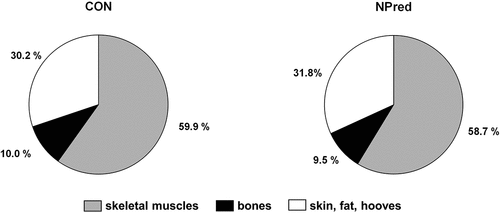Figures & data
Figure 1. Procedures of the body fractionation of 8 barrows (average live weight 123.3 ± 7.5 kg). The four fractions are highlighted in grey.

Table 1. Relative organ weights [g/kg live weight] of barrows at slaughter fed the control diet (CON, n = 4) or the diet with reduced nitrogen and phosphorus concentration (NPred, n = 4). Data are presented as means ± standard deviation.
Table 2. Clinical-chemical traits in blood serum of barrows at slaughter fed the control diet (CON, n = 3) and the diet with reduced nitrogen and phosphorus concentrations (NPred, n = 4). Data are presented as means ± standard deviation.
Table 3. Empty body weight (EBW), carcass weight, dressing percentage and fractions of full body analysis of barrows at slaughter fed the control diet (CON, n = 4) and the diet with reduced nitrogen and phosphorus concentrations (NPred, n = 4). Data are presented as means ± standard deviation.
Table 4. Chemical body composition of barrows at slaughter fed the control diet (CON, n = 4) and the diet with reduced nitrogen and phosphorus concentrations (NPred, n = 4). Data are presented as means ± standard deviation.
Figure 2. Regression between calculated and analysed body crude protein (CP) concentration of barrows from the present experiment (circle), a performance trial (plus) and a balance trial (cross) of Haude (Citation2003). For calculation, Equation 8 of GfE (Citation2006) was used. The black line shows the regression line, symbols show the observations (n = 71), grey shaded area shows the 95% confidence interval, the dashed lines the 95% prediction limits. The regression model is y = 0.53 + 1.01·x with RMSE = 0.92 kg and adjusted r2 = 0.36.

Table 5. Initial body crude protein (CP) concentration and calculated nitrogen (N) and phosphorus (P) retention of barrows fed the control diet (CON, n = 4) and the diet with reduced nitrogen and phosphorus concentrations (NPred, n = 4). Results are presented as means ± standard deviation.
Figure 3. Fractions of full body analysis relative to carcass weight of pigs fed the control diet (CON, n = 4) and the diet with reduced nitrogen and phosphorus concentrations (NPred, n = 4).

